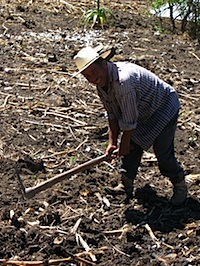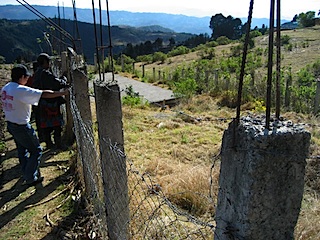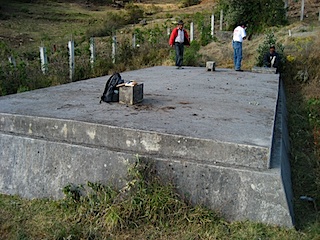Emily and I generally feel like we’re starting to get the hang of living in our village. The neighbors come by to chat, we get invited to cultural activities, we can occasionally speak in complete sentences in Q’anjob’al. Everyone smiles at us. Then, something like this comes along and makes me remember that no matter how much we progress, we still live in a small town full of people that are all related to each other, whose families have been here for hundreds of years, and have a culture completely alien to us. No, we actually don’t have a clue what the heck is going on here. Let me explain.
 Last month the dry season hit, and the stream by our house (and all the others in town) dried up. We now get our water from a few hoses that run down the mountainside from a spring several hundred feet above us, put in place by Nas Palas himself. Don Palxun, one of our neighbors, also gets his water in the same way. Last week I was helping Nas plant corn, and during a break we got to talking about water. He explained to me that the spring is jointly owned by the two of them, and there used to be 10 shareholders, but all the others sold their shares out to the community…and no longer have the right to use the spring. “Wow, why didn’t you two sell?” I asked. This is a sticking point with me, because for the village to get international aid for a water project, a prerequisite is that the town must own the spring, to ensure that it will always be shared properly. It struck me as strange that Nas Palas, the super community-minded guy, would be the holdout, and I wanted an explanation. “As you know,” he said, “The flow is really low on that sprng. It’s plenty for 10 families, but if the whole community uses it, there won’t be enough water for ANYONE. At least this way, it’s still benefitting somebody.” So he refused to sell. Sensible, practical, but still not very community-minded.
Last month the dry season hit, and the stream by our house (and all the others in town) dried up. We now get our water from a few hoses that run down the mountainside from a spring several hundred feet above us, put in place by Nas Palas himself. Don Palxun, one of our neighbors, also gets his water in the same way. Last week I was helping Nas plant corn, and during a break we got to talking about water. He explained to me that the spring is jointly owned by the two of them, and there used to be 10 shareholders, but all the others sold their shares out to the community…and no longer have the right to use the spring. “Wow, why didn’t you two sell?” I asked. This is a sticking point with me, because for the village to get international aid for a water project, a prerequisite is that the town must own the spring, to ensure that it will always be shared properly. It struck me as strange that Nas Palas, the super community-minded guy, would be the holdout, and I wanted an explanation. “As you know,” he said, “The flow is really low on that sprng. It’s plenty for 10 families, but if the whole community uses it, there won’t be enough water for ANYONE. At least this way, it’s still benefitting somebody.” So he refused to sell. Sensible, practical, but still not very community-minded.
Usually when I have these kinds of discussions, I then repeat back everything that was said.This is a good way to make sure I understood correctly, overcoming the language and cultural miscommunication that so often happens here. The Mayans are REALLY patient people, and a 10-minute recap doesn’t bother them in the slightest. This time, it got me even more information. “…and you and Palxun have water, but the rest of the village does not during the dry season,” I concluded.
Nas Palas raised his eyebrows. “Oh, most of them have water,” he corrected me. “About a hundred houses in town have agua entubada y chorros (a tubed distrubution system with water taps) connected to a big tank at the edge of town.” My jaw hit the floor; I’d never been told about this. He continued: “About 15 years ago, an aid project came and built it all. At the time, I was out of town working the coffee crop, so the village just skipped my house.” AHA! Now it’s all starting to make more sense. And Nas looked a bit bitter as he told that part of the story, though he tried to conceal his disdain for the situation.
Then I remembered seeing a tap in Manuel’s workshop, outside his house. “Oh, yeah, even Manuel has one,” Nas explained with a wink. “But he didn’t put it in; his grandma did that.”
This is all kindof embarassing, as Emily and I gave a lecture a few months ago on water systems, how they work, and how to solicit a project to develop one. In fact, we even did some preliminary negotiations with an engineer to design it and I took flow measurements at the spring. Of course, at no point in the process did anyone ever stand up and say, “Hey, dumbass, we know this stuff already and ran million-quetzal project like that 15 years ago.” It’s just another example of how they (don’t) communicate here.
A few days later I was hanging out with the aforementioned Manuel, our counterpart and president of the health comittee. “Come with me to the tank, we need your help,” he asked. Since I’d recently heard about the tank, I could play it cool and not be suprised; but also, it was a great chance to see it firsthand. Turns out, about this time every year the spring that feeds the town tank runs really low, and the water level in the tank goes down far enough that they can drain the tank entirely, clean it, and refill it. They wanted me to measure the tank and do a calculation on how much chlorine bleach to throw in to sanitize it afterwards. No problem, that’s easy.
We got to the tank and I was suprised. It’s a giant, below-ground deal with a big concrete lid. And by giant, I mean 60,000 liters. “Where did this COME from?” I asked the four men present. This launched a half-hour discussion where I feel like I finally got the full story… maybe. Turns out, an aid group from Europe came by and in 1994 helped them to construct the tanks, distribution system, spring enclosure, everything. They donated materials exceeding a million quetzales. It serves 68 houses, but the town has grown enough that it is no longer sufficient. They also told me that they are soliciting another water project, where they plan to cap Nas Palas’s spring (that the community has a 70% stake in), build a second tank nearby, and run a tube from that one to the big existing one to increase capacity. “But how do you know what to build? If the spring us big enough? What materials are needed?” I asked.
Turns out, about three years ago an engineer from a European NGO came by and worked up an estudio (research & design) for them that includes plans, topography, hydrology, tank engineering, and a materials list. “Would you like to see it?” they asked. You bet I would. “I can bring it over to your house next week,” one of the elders replied. They also told me that they are working with a lawyer in Huehuetenango, who is representing them as they solicit the 800,000q they need for the project. They are in negotiations with both the Spanish and Japanese embassies!
I guess my ignorant, helpless villagers aren’t so much after all. There is SO much we don’t understand here.

